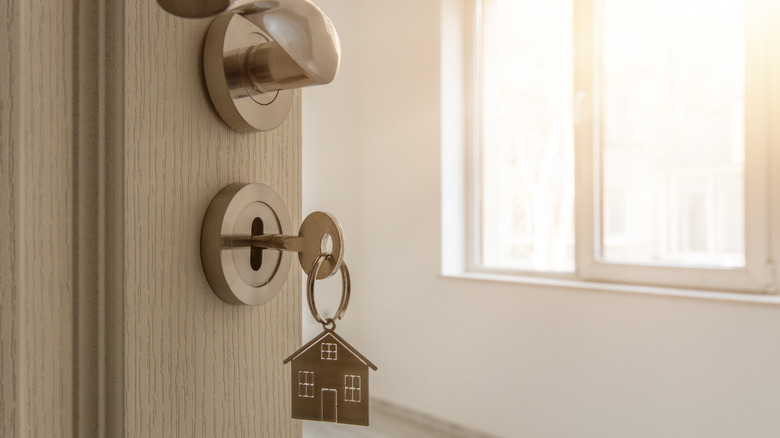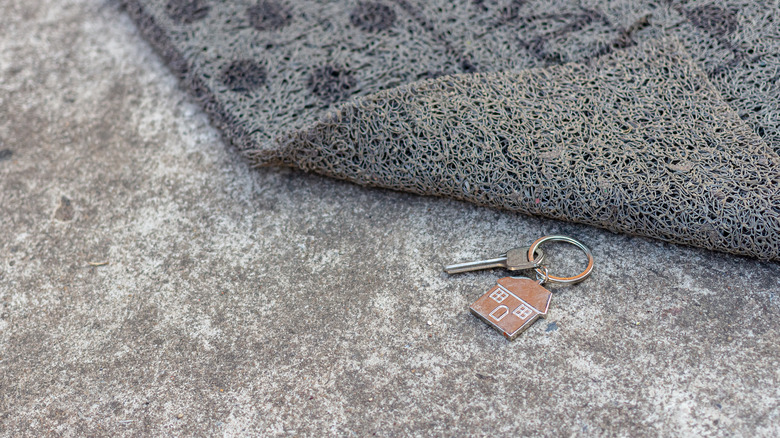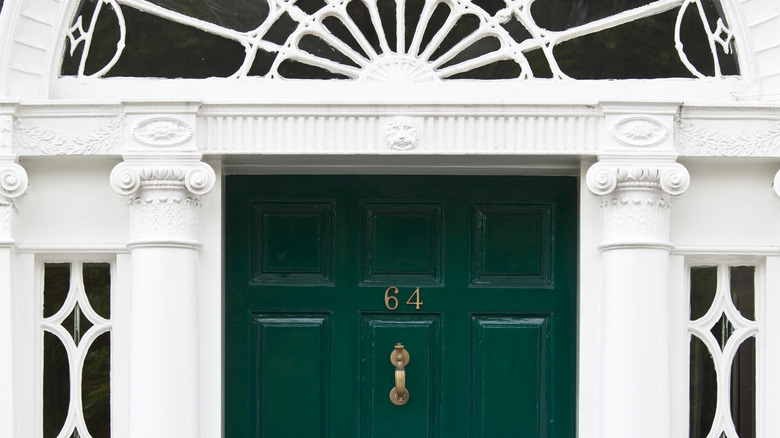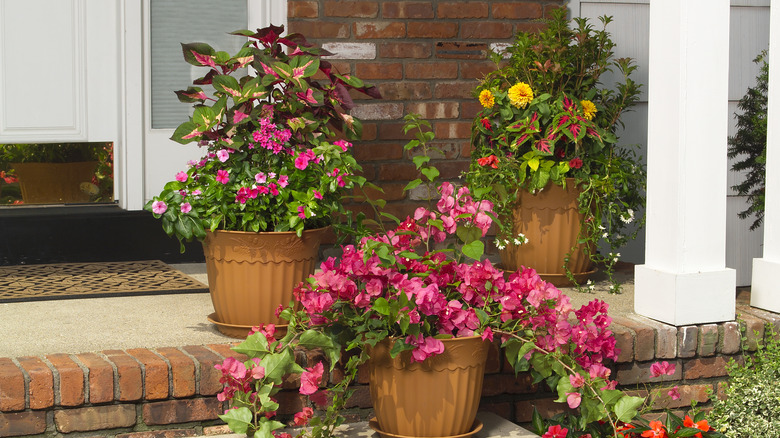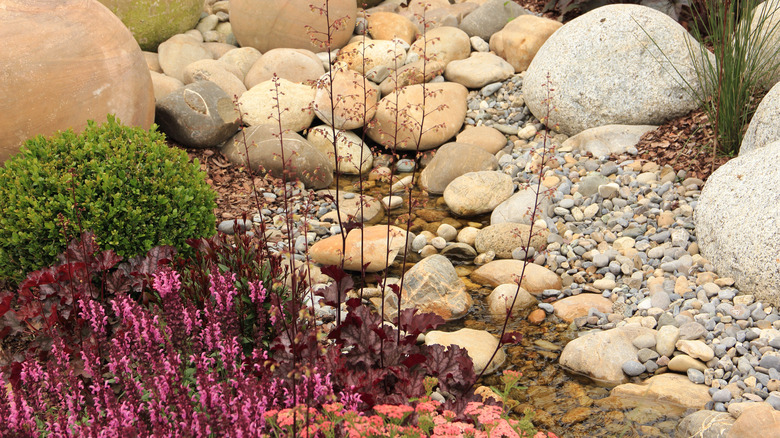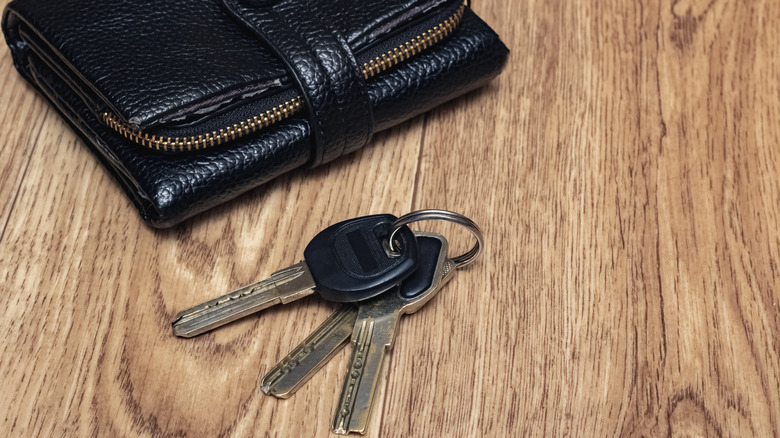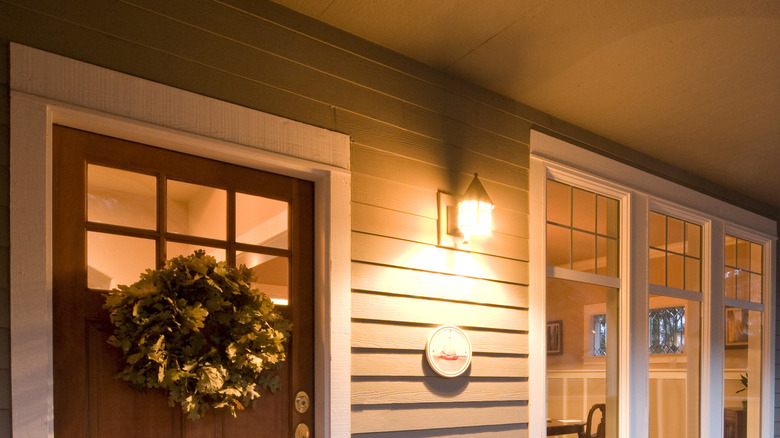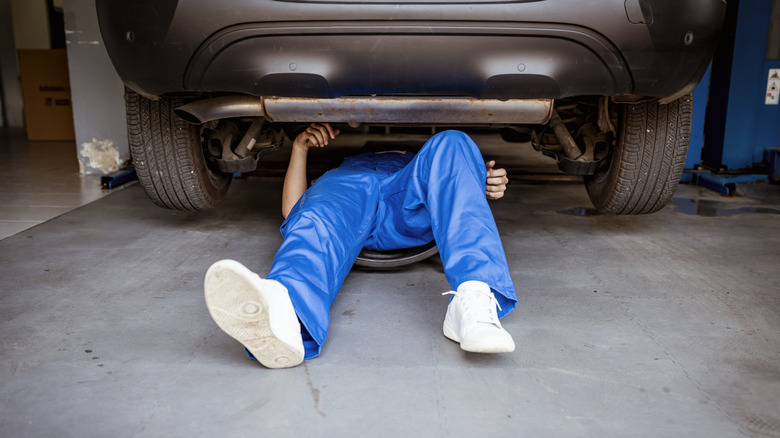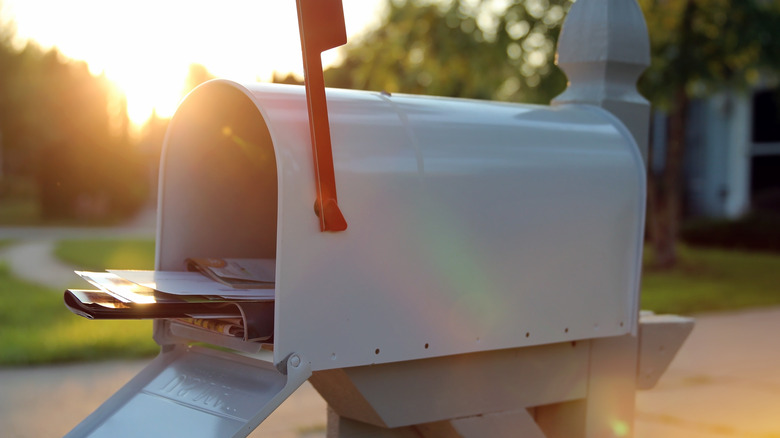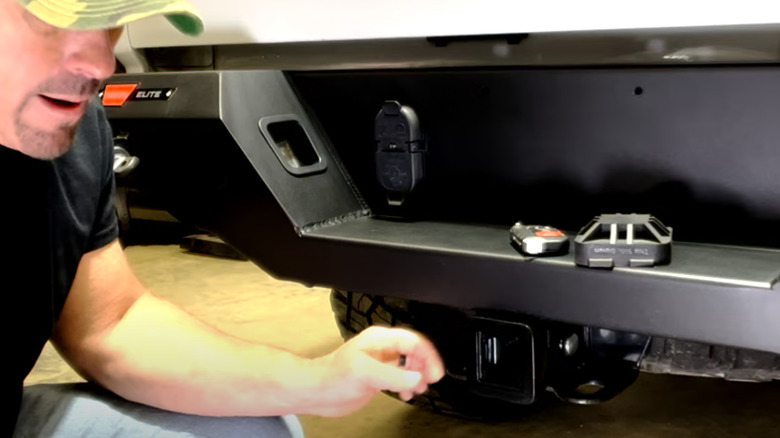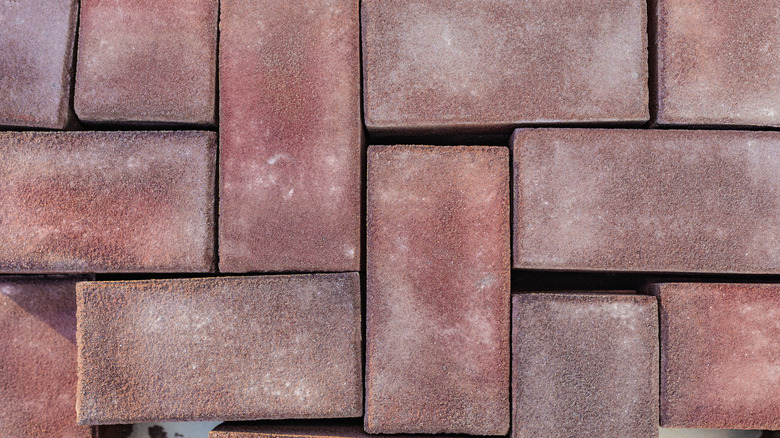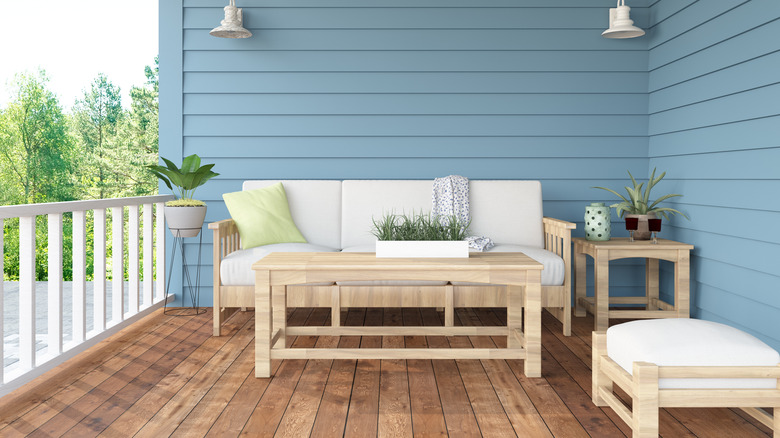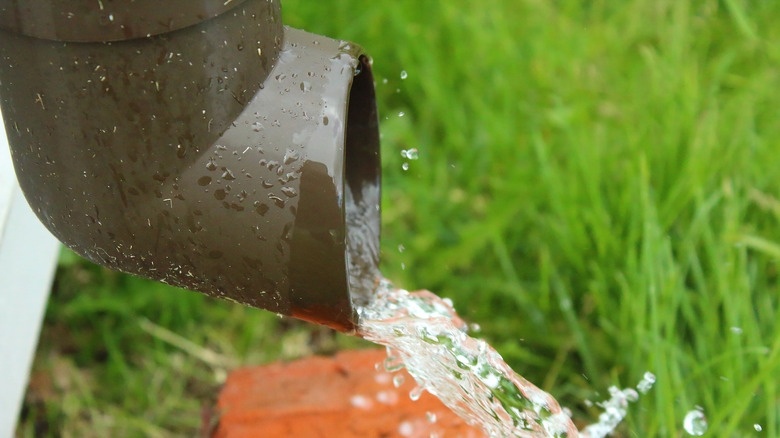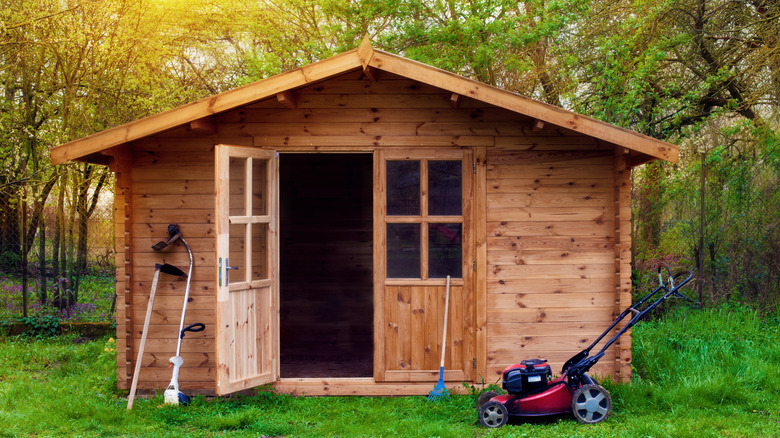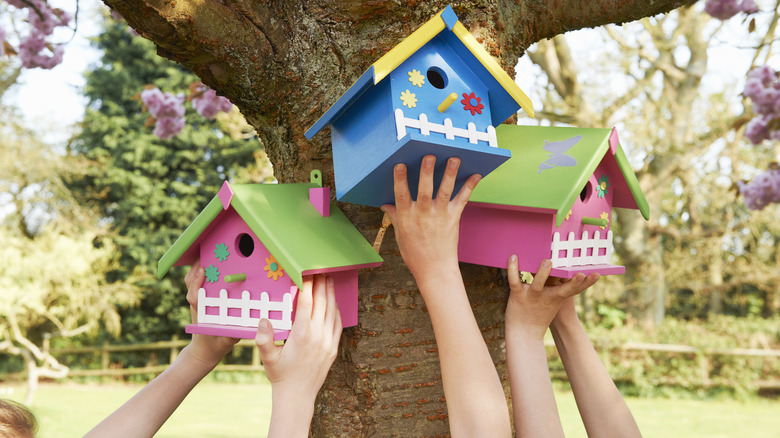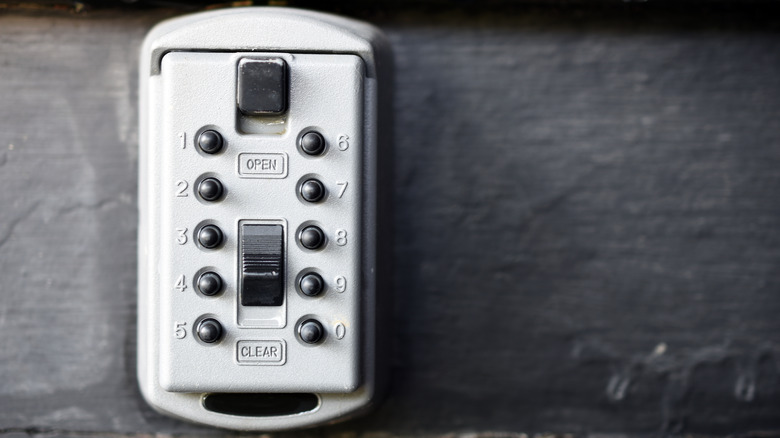Hiding A Spare Key In These Places Could Be A Safety Risk
Hiding a spare key is a common practice for a lot of us. According to Aviva, a British insurance company, about 1 in every 10 people hide a key outdoors when they leave home for an extended period. We can't always be home to let everyone in and need an easy way to let guests and service workers in when we are not around. However, we need to be mindful of where we hide the key to keep our home safe. A lot of the most common places that we might think to leave a key leave us vulnerable to a home invasion. So while you might prepare your home for vacation by locking the doors and setting the alarm, leaving a key in a spot most thieves would check could easily undo your efforts.
"It is really pretty simple to look and find the key. It is easy for the homeowner, but it's also easy for the thieves," security consultant Julius Ulanday told TVH11. "Don't waste time locking your door and putting a deadbolt and doing all this stuff to your door, if you are just going to leave the key outside." Of course, if someone is intent on entering your home, they won't care if they have a key or not. However, in most cases, you can increase the overall safety of your home by avoiding these hiding spots.
Under a doormat
According to Safewise, property crime is the top safety issue people lose sleep over. If you can relate, don't put your house key under your welcome mat. This is the first place most intruders will check for a key because it is so well known. In most media, the homeowner leaves a spare key under a doormat for friends and family to use. We've all seen this situation play out on TV and so have the criminals that want to rob your house. By choosing the most obvious place a thief would think of, you leave yourself vulnerable to a home invasion.
Overall, the doormat is too close to the door and too easy to check. You don't even have to be obviously looking for a key to uncover one in this hiding spot, as a thief could simply move the mat to the side with their foot without a neighbor noticing that anything was wrong at all. The underside of a doormat is also a very moist place, leaving a key placed there vulnerable to rust and corrosion.
Above the door lintel
Don't stash your spare key above the door lintel. In general, anywhere that a thief would not even need to leave your front porch for a key to get inside is a bad idea. Picture this: someone wants to get into your home. They checked under the mat and didn't find anything, but they are determined. When you are already on the porch, it's not hard to simply run your hand over the lintel and see if you can feel a key. A sneaky intruder could even disguise checking this spot as a bit of stretch, so no one walking by, or looking on from a doorbell camera, would be any wiser about it.
While some door lintels are tall enough that you might not be able to reach up there without a stool or a ladder, this kind of defeats the purpose of leaving a key there in the first place. What's the point of hiding a key for your dog walker if they can't even get to it?
Under a flower pot
Don't hide your spare key under a flower pot near the door as it's too close to the door and too obvious. What's convenient for you is also convenient for a crook, unfortunately. This is especially true if you only have one plant pot on your porch. Doing that is like putting a big sign on the pot that says, "Hey! I'm only here because my owner needed a place to hide a key! Check under me for a free trip inside the house."
According to Nationwide,1 in 3 burglars can just stroll into a house without force, often through an unlocked door. So the important part of creating deterrence is just making it harder for them to get inside. So, if you going this route, your porch needs to be large and have lots of plant pots on it. So many that checking under each would be very obviously out of the ordinary. This way, only those who you give exact directions to will be able to find the key. The plant pot you hide the key under should be far enough away from your front porch that it's not immediately obvious. Also, be careful about knocking soil out of the pot when retrieving the key as some thieves might look for this as a sign the pot was recently moved.
In a fake rock
You should be wary about purchasing one of those "fake rock" key hiding spots that are available at most hardware stores. The problem with these is that while they are a great idea in theory, they still tend to look pretty fake. If your flower beds are lined with rocks, the hiding spot will visually stick out even to the untrained eye. Even if you have rocky flowerbeds instead of mulch, the texture of a fake rock is still usually such that it's easy to tell it apart.
As soon as a thief sees that matte texture, they know exactly where to look to have easy access to your home. It's almost worse if you only have a few rocks in your yard or on the porch. Most intruders will see that and think, "Why is there a random rock just sitting here alone? Oh...that's where the key must be." And they would be correct. You also are unlikely to bring the rock inside with you every time you get home. This could be a safety risk, as the United States Department of Justice estimates that 28% of robberies happen when someone is home and 7% of these break-ins result in violent crime. So leaving a key out in such an obvious place leaves you at risk of bodily harm.
In your wallet
Most of us have our house key on the same keychain as our car keys. This is typically not a security risk. If those keys are stolen, the thief would have to find your car, then search your car for your home address, then drive to your home and break into it. While this is certainly possible, the steps it takes are not something the normal "smash and grab" criminal would care to complete.
What is a risk, however, is leaving a spare house key in your wallet. If your wallet is stolen or lost, your driving license with your full name and address will be in it, along with the key. That means that someone intent on harming you could not only know your address, but also have the easiest way to get inside. Without a swift resolution, you'll probably find yourself changing locks as well as credit cards. To save yourself the effort, keep your house key separate from your address.
Inside a light fixture
In the daytime, a spare key nestled inside a light fixture on your front porch might seem like the perfect spot. This is especially true if the glass is frosted or opaque, as you can't see through it. However, what happens when you are on vacation and your smart home turns on the front porch light? Everyone passing by will see the perfectly illuminated outline of a key glowing inside the light fixture. UNC Charlotte did a home invasion survey and found that 41% of home invasions are a "spur of the moment" type of event.
Since the same survey found that one in eight burglars used a key to enter the premises they intended to rob, setting up your key as a glowing beacon is not a good way to keep your home safe. Instead, skip using any light fixtures as a hiding spot because even in the daytime, it would still be easy for a potential threat to stick their hand inside and check for a key.
Under your car
According to home insurance company Compare the Market, the number one thing insurance adjusters look for when investigating a claim is forced entry into your home. This could be damage to the door hinges where the intruder kicked it in or a smashed window. Unfortunately, if you leave your spare key out in the open, like under a car tire in your driveway, there will be no signs of forced entry and anyone can just walk right into your house. This means that whatever was stolen or damaged might not be covered or replaced, even if you have a good home insurance policy.
You need to make it as hard as possible for someone to find your key, so placing it under your car's tire isn't smart. If you are leaving it for someone specific to find, you can't lodge it far enough under the tire for it to be secure. Your friend likely won't have keys to move your car, nor would you ask them to lie down on the driveway to retrieve the house key from under the middle of the car, either. There just isn't a safe or convenient way to hide a key under any part of a car.
Inside a mailbox
A mailbox is a fairly easy target for an unwelcome person trying to find your spare key. It's sometimes on the edge of your property and generally unattended. It's too big of a safety risk to leave access to your home so unmonitored like this, as it takes very little effort for someone strolling by to simply open the box (which is typically empty) and notice a shiny key inside. However, for those few moments a day when your mailbox is actually full, leaving a spare key inside the box actually leaves you vulnerable to losing your key altogether.
A small key can easily be caught up in a stuffed mailbox and end up being pulled into the mail truck with an outgoing package or get knocked into the gutter in front of your house. Then your key would be even more vulnerable. Even if you purchase a small magnet to store your key inside your mailbox, stealing or tampering with mail is a federal offense per the United States Office of the Law Revision Counsel. This means that you can face serious fines and jail time for messing with people's mail, so it's probably not a good idea to ask your neighbor to go tearing apart your mailbox when they need to water your plants, just in case.
In a magnetic key holder attached to the car
This option may be convenient, but it's not secure, as thieves can easily spot it and steal the key. These keyholders are a bit like small lock boxes with one main difference: they aren't as secure. A lock box is permanently secured to your home. A magnetic key holder could easily be plucked right off the car and taken to a secondary location to be broken open. While someone hitting a lock box on your porch with a hammer trying to break it open is obviously theft, someone running over a magnetic lock box, or taking it to a local park and hitting it with a hammer before returning to your home isn't as obvious.
Sure, a thief coming across this lock box while you're parked at work or the mall isn't going to get very far. But someone who wants to get inside your home while your car is sitting in the driveway will have a very easy time of it.
Under a loose brick or stone in a pathway
This hiding spot is unfortunately very similar to using a fake stone to hide your key. If someone wants to find your hiding spot, they typically know what to look for. Anything near the door that looks like it moves around a lot is a prime target. This includes a loose brick on your porch or a stone in your walkway. Even if you don't hide anything under it, the wobble of a loose brick is entirely obvious, making it a prime place to check.
This isn't safe as the key could be dislodged or moved around. It's also possible that the key could be warped by the pressure of people standing on the stone above it, rendering it useless. Whether you are leaving a key for your house sitter or your little sister, they won't be able to use it if it's bent or broken, making this option both unsafe and inconvenient.
Under a bench or other outdoor furniture
You might be tempted to just pop the key under the leg of your outdoor furniture, but this is still a place thieves could think to look. It's an especially insecure spot because anyone casing your house will easily see you hiding the key or your house sitter picking it up. This is because moving a chair, stool, or table outside to grab a key is a pretty obvious action. In addition, if you have a raised front porch or a deck, leaving a key on the ground leaves you vulnerable to losing it between the slats. This is likely to happen when sliding the furniture around to retrieve the key.
In this case, you are left with two equally undesirable options: your friend losing your key under the porch and calling you in a panic because they can't get in your house to let your dog out, or still getting the call because the key isn't there anymore and your house has been burglarized.
In the gutter or downspout
While this may seem like a creative hiding spot, it's not secure, as it's easy to dislodge the key. Let's say there is a particularly heavy rainstorm while you are away. A steady flow of water could easily push out your key, causing it to lie out in the flowerbed where anyone could take it. In addition, the edges of the gutter or downspout can often be jagged or rusty, making it a safety risk to ask friends or family to stick their hands inside looking for the key.
Should anyone cut themselves on your drainage system, you are at risk of being held liable, particularly if they should develop any sort of infection or something more serious like tetanus from the injury. Because of the risks to both your home's safety and the health of those who use the keys, it is not worth it to place a spare in the gutter or downspout.
Inside a toolbox or storage shed
While hiding a key inside a toolbox inside your storage shed might seem like a good idea because it's hidden twice, it's not very practical, especially in an emergency. If you are locked out of your home and need to retrieve the spare key quickly, you may not have the time or resources to access a key hidden so deeply. Without specific instructions, a key in this location could also be difficult for a gardener, housesitter, or even emergency personnel to find quickly and easily.
It can be a safety risk to send someone who isn't a member of your household rummaging around in a shed filled with precariously balanced boxes, tools like saws and hammers, and old sentimental items. In addition, for this hiding spot to work you would need to leave the shed unlocked, which leaves the things inside vulnerable ... which kind of defeats the whole purpose of hiding the key to your house in the first place.
In a birdhouse
You might think a birdhouse is a good hiding spot, but it's still not secure in most cases, as burglars know to check even the most unusual spots. However, if you have a few birdhouses on your property and they are fairly intricate, this spot almost borders on okay. For example, if you have six birdhouses around your property and the key to the back door is inside the one farthest from the house, around the side of the garage, it might be an okay option.
This isn't as obvious of a hiding spot as it's so far away from the back door and would take time and effort to uncover. The safety risk would be having a birdhouse hanging right next to your door and placing a key inside there. Sure, that would make it easier for you to grab when you are in a rush, but the same could be said for a potential intruder.
Where should you hide your spare key?
Sometimes you need to leave a spare key. Maybe you run a vacation rental business and do remote check-in and out. Maybe you don't want your dog walker to always have a key to your home because they only come on Thursdays. Maybe you are just forgetful and need a spare around, just in case.
Calder Security recommends that the only truly secure way to hide a spare key is in a police-approved key safe. This way, you can give trusted people the code instead of telling them where you hid the key. You can change the code as needed between guests or if you get a new dog walker. This way, you never have to worry about someone you gave a spare key to just popping by whenever (as they would have to get it out of the box with the most recent code) or an intruder that just so happens to find the key while they are snooping around. Key safes are a bit more secure than just your typical lock box, making them an excellent and convenient option for a spare key.
